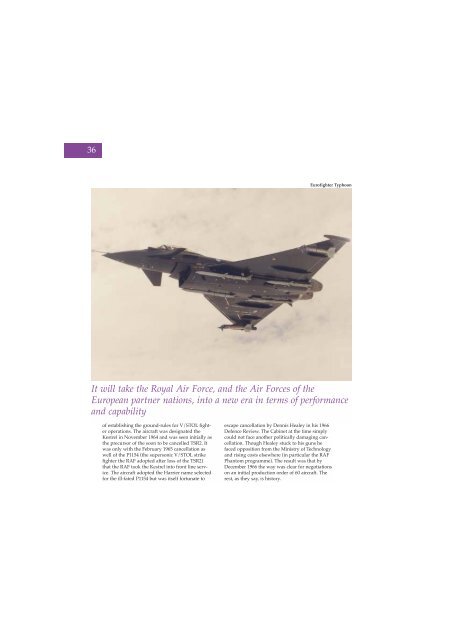Volume 6 No 4 - Royal Air Force Centre for Air Power Studies
Volume 6 No 4 - Royal Air Force Centre for Air Power Studies
Volume 6 No 4 - Royal Air Force Centre for Air Power Studies
Create successful ePaper yourself
Turn your PDF publications into a flip-book with our unique Google optimized e-Paper software.
36<br />
Eurofighter Typhoon<br />
It will take the <strong>Royal</strong> <strong>Air</strong> <strong>Force</strong>, and the <strong>Air</strong> <strong>Force</strong>s of the<br />
European partner nations, into a new era in terms of per<strong>for</strong>mance<br />
and capability<br />
of establishing the ground-rules <strong>for</strong> V/STOL fighter<br />
operations. The aircraft was designated the<br />
Kestrel in <strong>No</strong>vember 1964 and was seen initially as<br />
the precursor of the soon to be cancelled TSR2. It<br />
was only with the February 1965 cancellation as<br />
well of the P1154 (the supersonic V/STOL strike<br />
fighter the RAF adopted after loss of the TSR2)<br />
that the RAF took the Kestrel into front line service.<br />
The aircraft adopted the Harrier name selected<br />
<strong>for</strong> the ill-fated P1154 but was itself <strong>for</strong>tunate to<br />
escape cancellation by Dennis Healey in his 1966<br />
Defence Review. The Cabinet at the time simply<br />
could not face another politically damaging cancellation.<br />
Though Healey stuck to his guns he<br />
faced opposition from the Ministry of Technology<br />
and rising costs elsewhere (in particular the RAF<br />
Phantom programme). The result was that by<br />
December 1966 the way was clear <strong>for</strong> negotiations<br />
on an initial production order of 60 aircraft. The<br />
rest, as they say, is history.
















